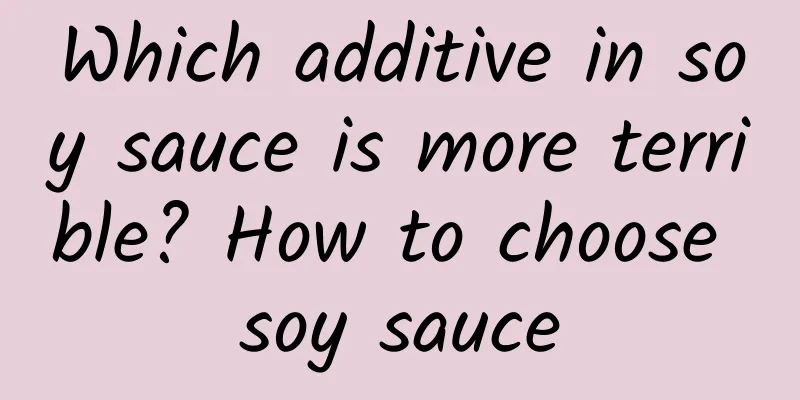Which additive in soy sauce is more terrible? How to choose soy sauce

|
During the holidays, several acquaintances and friends asked me about the additives in soy sauce. They said they read an article that went viral on WeChat Moments, saying that a certain company's soy sauce had "double standards", with domestic products containing a lot of additives, while products exported abroad had clean ingredients. They said they didn't know what kind of soy sauce to eat... Which additive in soy sauce is the most dangerous? I will work overtime during the holiday to give you a brief introduction to what food additives are in soy sauce , why they are added, and how safe they are. Then I will talk about how to choose soy sauce , what indicators to look at, and how to consume soy sauce reasonably. 1. What additives are added to soy sauce? Why are they added? The main ingredients of any soy sauce are these four things: water, soybeans (yellow soybeans or black soybeans), wheat (flour), and salt. Therefore, they will occupy the first four positions in the ingredient list. In the following, possible additional ingredients are: Category 1: sweet substances such as white sugar, fructose syrup, and sucralose. People all know that when cooking salty dishes, adding a spoonful of sugar can make the taste more delicious and mellow. So braised pork, braised pork, etc. need sugar, fish-flavored pork shreds, Kung Pao chicken need sugar... Adding a small amount of sugar to soy sauce will also make the salty taste soft, delicious and rich. There is no need to explain much about white sugar. Fructose corn syrup is a product made by enzymatic hydrolysis of corn starch. It is composed of glucose and fructose and has a refreshing and delicious sweet taste. Fructose corn syrup is the main ingredient of beverages such as Coke and Sprite. Sucralose is a sweetener with high sweetness and positive sweetness. China permits its use in more than 20 types of food, including soy sauce. This sweetener was first developed by the British and approved by the Joint Expert Committee on Food Additives (JECFA). It was first used in Canada, and the United States is its largest sales market. The second category: flavor-enhancing substances such as monosodium glutamate, disodium 5'-flavor nucleotides (sodium inosinate and sodium guanylate), and yeast extract. Monosodium glutamate is the MSG extracted from kelp by Japanese scholars more than 100 years ago. Disodium 5'-ribonucleotide is a flavorful substance found in chicken soup and meat broth. One of the reasons why products such as "de-acidified meat" are more delicious is that more disodium 5'-ribonucleotide is produced during the ripening process of fresh meat. Nucleotides exist in the nucleic acids (DNA and RNA) of all organisms, including the human body. They are not some strange artificial synthetic substances. Yeast extract is a product made by enzymatically hydrolyzing the protein and nucleic acid in yeast, separating the umami substances, and concentrating them to make a flavor-enhancing product. It not only contains umami substances such as 5'-ribonucleotide disodium and amino acids, but also contains a variety of B vitamins. (Do you remember the product "yeast tablets"?) In short, flavor enhancers are not something to be feared. The key is not to eat too much. If the natural flavor of food is lost, everything you eat will taste like yeast hydrolyzate or MSG chicken essence, which is very boring. Category 3: preservatives such as sodium benzoate, potassium sorbate, and sodium dehydroacetate. Soy sauce contains a lot of salt, which has a certain antibacterial ability. Salt is the oldest preservative, but when there is too much salt, the soy sauce will be very salty, which is neither delicious nor healthy. If the salt content is reduced, the antibacterial ability will decrease. After all, we can't use up the soy sauce in one day. A bottle of soy sauce can be used for one or two months. If it is left at room temperature every day, microorganisms may multiply and grow a layer of "mold", or even mold may exceed the standard. To prevent this from happening, only a small amount of preservatives need to be added, and there is no risk of "exceeding the standard" (after all, food additives also cost money to buy, and adding more after the effect is achieved is meaningless). Sodium benzoate and potassium sorbate have been widely used in countries around the world for decades, and no relationship has been found between them and cancer risk. Sorbic acid itself is a substance present in human metabolism, and its toxicity (median lethal dose) is even lower than that of salt. Benzoic acid is also a substance present in many fruits, such as blueberries and cranberries, so there is no need to be afraid. For soy sauce, if you want to avoid adding preservatives, you need to add more salt; and if you want to ensure the safety of reduced-salt products, you need to add preservatives. Studies have shown that the dietary factor that contributes most to the risk of cardiovascular death in China is excessive sodium intake. Therefore, reducing salt is the top priority. Eating soy sauce without preservatives will not make people live longer . Category 4: caramel color. Caramel coloring is only added to dark soy sauce products, not light soy sauce. This is because it has a strong "coloring" ability. Adding one or two spoons can turn a pot of food brown, making it suitable for braised and marinated foods. Caramel is the brown substance produced when sugar color is fried . To make foods such as candied haws and candied yam, you need to heat and melt the sugar. After the sugar is heated and melted, its color slowly turns brown, and this color is caramel color. Of course, there are different types of caramel coloring produced by modern industry. Some are used in beverages such as cola, some are used in bakery snacks (such as Black Forest cake, cocoa biscuits, etc.), and some are used in condiments such as soy sauce and sauces. Why is it not scary to drink a lot of caramel coloring from Coke, and not scary to eat brown cookies and snacks, but it is so scary to eat a little caramel coloring in soy sauce? 2. How to choose soy sauce? According to the latest regulations in our country, only pure brewed soy sauce products can be called "soy sauce". If ingredients similar to soy sauce are added, which are not brewed but made by chemical hydrolysis or enzymatic hydrolysis, it cannot be called soy sauce, but can only be called "such and such seasoning liquid". Therefore, consumers no longer need to worry about the problem of "prepared soy sauce" impersonating brewed soy sauce . The question now is how to choose among the various types of soy sauce. First, we need to look at the amino acid nitrogen content of soy sauce. The grade of soy sauce is divided by "amino acid nitrogen". It reflects the amount of amino acid substances produced during the soy sauce brewing process, and is closely related to the umami flavor and nutritional value of soy sauce. It can be said to be the "dry goods" indicator of soy sauce. Amino acid nitrogen ≥ 0.40%: Grade 3 soy sauce. Amino acid nitrogen ≥ 0.55%: Grade 2 soy sauce. Amino acid nitrogen ≥ 0.70%: first-grade soy sauce. Amino acid nitrogen ≥ 0.80%: premium soy sauce. Of course, some products have higher levels of amino acid nitrogen, up to 1.20%~1.30%. Such soy sauce is naturally the best quality , not only delicious, rich in taste and aroma, but also theoretically, with higher nutritional value such as multiple B vitamins and minerals. Looking at this indicator is much more reliable than shaking the bottle to see the foam (adding thickener can make the foam richer), pouring it on food to see the coloring effect (adding caramel color will make the color darker), tasting the umami flavor with the tongue (adding more MSG and sodium nucleotide salt will make it tastier). Secondly, it depends on the purpose of the soy sauce. If you want a rich color when making braised dishes, choose dark soy sauce. If you want a fresh and fragrant taste and a refreshing color when making stir-fried dishes or salads, use light soy sauce. Some soy sauces are dual-purpose and do not specify whether they are dark or light. You can check the ingredient list to see if there is "caramel coloring". If not, the coloring ability will not be that strong. Third, look at the sodium content. Reducing the sodium content of soy sauce is an important option for health-conscious consumers. The nutritional information table of soy sauce usually uses "a serving" per 10g/ml or per 15g/ml to indicate the sodium content. One spoonful of soy sauce is about 10g, so this is a more convenient way to label it. Be sure to convert all products into 10 grams, and then among the products with the highest amino acid nitrogen content, choose the one with the lowest sodium content. For example, two products are both "premium soy sauce". The amino acid nitrogen of product A is 1.20%, and each 10-gram serving contains 495 mg of sodium; the amino acid nitrogen of product B is 0.90%, and each 15-gram serving contains 1132 mg of sodium. Then, when both are converted to 10 grams, the sodium content of product B is 754 mg. Obviously, product A has a higher amino acid nitrogen content and a lower sodium content, making it better than product B. Fourth, don’t pay too much attention to meaningless words like “zero additives”, “first batch”, and “special brew”. To determine whether it is high-quality soy sauce, just look at the data. All kinds of arguments are not important. Let me explain here that the food additives approved for use in our country are almost all varieties permitted for use in other countries. The so-called "foreign countries do not use food additives" is a complete rumor . Even if you can't read English or Japanese, you can buy a bag of potato chips or a bottle of Coke, read the Chinese ingredient list on the back, and find out whether there are food additives in products produced by foreign companies. If you really mind food additives, you can buy organic soy sauce and "zero-additive" soy sauce produced by major brands in China . There is no such thing as "additive products are sold in China, and zero-additive products are sold abroad." If you can't buy it in the supermarket, you can just buy it online. However, the so-called "zero-additive" does not mean the product is the safest, nor does it mean the product is the best quality. 3. Tips for using soy sauce in cooking When cooking with soy sauce, the most important technical points are: Use high-quality soy sauce, add soy sauce to the dish after it’s done cooking, and reduce the amount of other condiments. Soy sauce has a strong aroma and contains a small amount of sugar and flavor enhancers, so there is no need to add MSG or chicken essence. Sugar can be used less or not, and the amount of salt can also be reduced . The delicious taste and aroma of soy sauce cannot be replaced by salt and chicken essence. It makes it easier to season dishes: no salt is added at the beginning, just add one or two spoons of soy sauce when serving. Good soy sauce without caramel coloring can add a thin layer of red to the cut edges of vegetables without affecting the overall green color of the vegetables. (You can imagine the state of the dish "Hand-shredded Cabbage", which is a classic dish that does not add salt to stir-fry dishes and adds soy sauce when serving.) There are four benefits of pouring soy sauce on the pot: First, avoid soy sauce from penetrating into the dishes and affecting their color; Second, it is to prevent the soy sauce from becoming burnt due to heating, which will affect the flavor; The third is to let the saltiness adhere to the surface of the dish without penetrating into the inside, which can reduce the salt (sodium) by at least one third while achieving the same salty taste. Fourth, you can achieve a sweet taste with a small amount of sugar in soy sauce without adding a large spoonful of sugar. In short, using soy sauce in this way can easily reduce salt and sugar, and increase nutrients. Soy sauce contains a variety of B vitamins, potassium, magnesium and other nutrients. Although the amount is small, a little more is a little more. Salt and sugar do not contain other nutrients except sodium and sugar. Okay, everyone, enjoy the delicious taste brought by high-quality soy sauce! Reprint/ Cooperation please contact Weibo/ Official Account: Fan Zhihong_Original Nutrition Information |
<<: If aliens come, can humans hide if they can't defeat them?
>>: The creature in the world that looks most like a dragon is actually a "nerd"!
Recommend
How to increase App users by not filling in invitation codes
What should we do when fission marketing becomes ...
For a lottery event, should we set up “giving out more small prizes” or “drawing a lucky big prize”?
The 2020 Double Eleven has come to an end, and ma...
It is the domestic brands that offer rewards and engage in black public relations. Why are joint venture brands always silent? Here is the reason!
The “anti-gang storm” in China’s auto industry do...
Apples are too big to finish, and half of them will turn black. This Nobel discovery says goodbye to oxidized apples
Have you ever had this problem: the apple is too ...
Tea Science | Where does the "orchid fragrance" in tea come from? Uncover the mystery of tea aroma
01 What is orchid fragrance? Orchids, a species o...
iPhone iOS's built-in email function is not as good as more localized third-party apps
In the era of mobile office, the demand for sendi...
Wei Buhuo: A short video editing course that novices can learn in one go, solving common problems you encounter in daily editing
Wei Buhuo: A short video editing course that even ...
What is information flow promotion? After doing bidding promotion, do I still need to do information flow promotion?
There are two mainstream promotion types nowadays...
How to write the Double 12 event plan? This universal solution is for you!
It feels like everyone is busy and exhausted from...
Is it worth a fortune to stay slim in old age? Even if you are thin, you must have muscles and bones!
As the saying goes, "It's worth a fortun...
Why is the sky blue? And not all seven colors like a rainbow?
Looking up, it was another beautiful day with blu...
What does the sun's closest neighbor look like? Are there Trisolarans on Proxima Centauri?
Proxima Centauri is the closest star to the solar...
Meituan Grocery APP Product Analysis
The growth of user scale and the maturity of deli...
How to improve user retention rate? Share 6 rules!
Retention rate is the most important criterion fo...
Why are there more mobile phone CPU brands than computers?
The progress of CPU production for PCs in China h...









